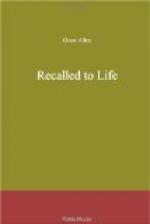That horrible article in the penny Society paper came back to my mind once more with hideous suggestiveness. I turned to him almost fiercely.
“So far as you know, Dr. Marten,” I asked, “was I ever in love? Had I ever an admirer? Was I ever engaged to anyone?”
He shrugged his shoulders and smiled a sort of smile of relief.
“How should I know?” he answered. “Admirers?—yes, dozens of them; I was one myself. Lovers?—who can say? But I advise you not to push the inquiry further.”
I questioned him some minutes longer, but could get nothing more from him. Then I rose to go.
“Dr. Marten,” I said firmly, “if I remember all, and if it wrings my heart to remember, I tell you I will give up that man to justice all the same! I think I know myself well enough to know this much at least, that I never, never could stoop either to love or to screen a man who could commit such a foul and dastardly crime as this one.”
He took my hand fervently, raised it with warmth to his lips and kissed it twice over.
“My dear,” he said, with tears dropping down his gentle old cheeks, “this is a very great mystery—a terrible mystery. But I know you speak the truth. I can see you mean it. Therefore, all the more earnestly do I beg and beseech you, go away from Woodbury at once, and as long as you live think no more about it.”
CHAPTER VIII.
A VISION OF DEAD YEARS
The interview with Dr. Marten left me very much disquieted. But it wasn’t the only disquieting thing that occurred at Woodbury. Before I left the place I happened to go one day into Jane’s own little sitting-room. Jane was anxious I should see it—she wanted me to know all her house, she said, for the sake of old times: and for the sake of those old times that I couldn’t remember, but when I knew she’d been kind to me, I went in and looked at it.
There was nothing very peculiar about Jane’s little sitting-room: just the ordinary English landlady’s parlour. You know the type:—square table in the middle; bright blue vases on the mantelpiece; chromo-lithograph from the Illustrated London News on the wall; rickety whatnot with glass-shaded wax-flowers in the recess by the window. But over in one corner I chanced to observe a framed photograph of early execution, which hung faded and dim there. Perhaps it was because my father was such a scientific amateur; but photography, I found out in time, struck the key-note of my history in every chapter. I didn’t know why, but this particular picture attracted me strangely. It came from The Grange, Jane told me: she’d hunted it out in the attic over the front bedroom after the house was shut up. It belonged to a lot of my father’s early attempts that were locked in a box there. “He’d always been trying experiments and things,” she said, “with photography, poor gentleman.”




